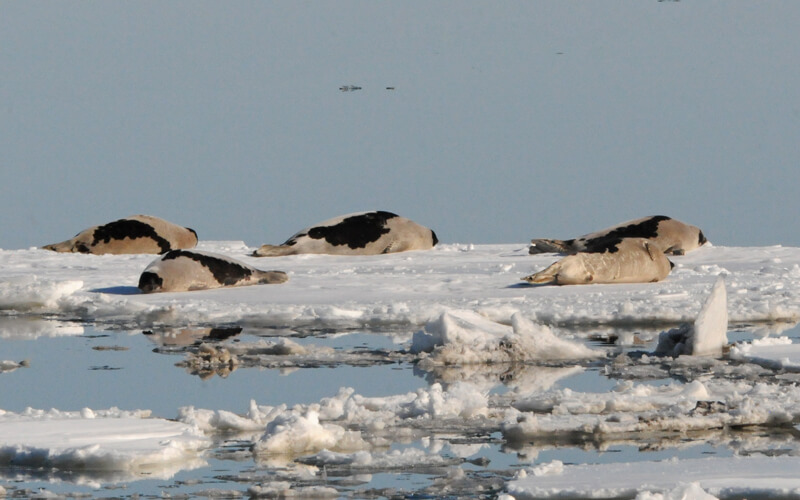“I’ve never seen so many seals on this side of the peninsula,” exclaims one observer posted in the Gaspé town of Cap-des-Rosiers. On January 29, over a several kilometres long stretch of the St. Lawrence, she sees seals drifting on the ice floes. The animals are too far away to identify the species, but at this time of year chances are they are harp seals.
This species is a winter visitor to the St. Lawrence. Particularly gregarious, harp seals form herds in winter that can number in the thousands. When swimming, the harp seal sometimes performs a sort of backstroke, and is the only pinniped to do so. On the ice, it lies on its side or on its belly and soaks in the sun to warm its fur.
On January 31, near Pointe-Saint-Pierre on the other side of the Gaspé Peninsula, thousands of seals drift on a patch of ice. The observer watches them at first through her binoculars, then through a spotting scope to better admire the seals’ attire. Most appear to be the harp seals, but some of them show rather grey coats with speckling. Grey seals? Good question, and a tough one in the absence of a photo.
In fact, even with good pictures, identifying seal species is not always so straightforward. All seals will see the colour of their coat change with each moult and as they age. For example, harp seal and grey seal pups are born with a white coat called lanugo. To differentiate the two species visually, one must rely on the shape of the snout.
The lanugo will change from day to day and evolves differently in each of the two species. According to researchers, the harp seal has eight stages of variation before it acquires its adult colour pattern at around the age of four years. In grey seals, the coat is especially variable in the first few weeks after birth, and young will acquire their adult coat by the time they are about one year old. For both these species, when they are in the so-called “beater” stage, the coat will be speckled with spots and identification based on the coat alone can be difficult.
On February 1, in the town of Gallix on the North Shore, some seals dive between the ice floes while others rest. The one diving are probably feeding. Harp seals are not finicky when it comes to eating. Analyses of the contents of their digestive system have identified no fewer than 120 species of fish or invertebrates! Even in a single individual, researchers have already noted 60 different species still present in the digestive system, meaning they were consumed shortly before the animal died.
On February 4, around 80 harp seals take advantage of newly formed ice off the coast of Les Escoumins, in Quebec’s Haute-Côte-Nord region. Currently, the harp seal population that frequents the St. Lawrence appears to be in good health, and is estimated to number a few million individuals. On the other hand, diminishing ice cover could adversely affect the species’ reproduction and pup survival.







